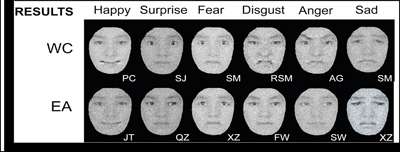Perception of facial expressions differs across cultures

Facial expressions have been called the "universal language of emotion," but people from different cultures perceive happy, sad or angry facial expressions in unique ways, according to new research published by the American Psychological Association.
"By conducting this study, we hoped to show that people from different cultures think about facial expressions in different ways," said lead researcher Rachael E. Jack, PhD, of the University of Glasgow. "East Asians and Western Caucasians differ in terms of the features they think constitute an angry face or a happy face."
The study, which was part of Jack's doctoral thesis, was published online in APA's Journal of Experimental Psychology: General. Jack is a post-doctoral research assistant, and the study was co-authored by Philippe Schyns, PhD, director of the Institute of Neuroscience and Psychology at the University of Glasgow, and Roberto Caldara, PhD, a psychology professor at the University of Fribourg in Switzerland.
Some prior research has supported the notion that facial expressions are a hard-wired human behavior with evolutionary origins, so facial expressions wouldn't differ across cultures. But this study challenges that theory and used statistical image processing techniques to examine how study participants perceived facial expressions through their own mental representations.
"A mental representation of a facial expression is the image we see in our 'mind's eye' when we think about what a fearful or happy face looks like," Jack said. "Mental representations are shaped by our past experiences and help us know what to expect when we are interpreting facial expressions."
Fifteen Chinese people and 15 Caucasians living in Glasgow took part in the study. They viewed emotion-neutral faces that were randomly altered on a computer screen and then categorized the facial expressions as happy, sad, surprised, fearful, disgusted or angry. The responses allowed researchers to identify the expressive facial features that participants associated with each emotion.
The study found that the Chinese participants relied on the eyes more to represent facial expressions, while Western Caucasians relied on the eyebrows and mouth. Those cultural distinctions could lead to missed cues or misinterpreted signals about emotions during cross-cultural communications, the study reported.
"Our findings highlight the importance of understanding cultural differences in communication, which is particularly relevant in our increasingly connected world," Jack said. "We hope that our work will facilitate clearer channels of communication between diverse cultures and help promote the understanding of cultural differences within society."
More information: "Internal Representations Reveal Cultural Diversity in Expectations of Facial Expressions of Emotion," Rachael E. Jack, Roberto Caldara and Philippe G. Schyns, PhDs; University of Glasgow; Journal of Experimental Psychology: General; Vol. 141, No. 1. Full text of the article is available from the APA Public Affairs Office and at: www.apa.org/pubs/journals/rele … cial-expressions.pdf


















